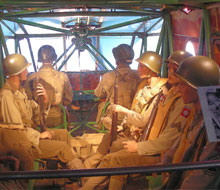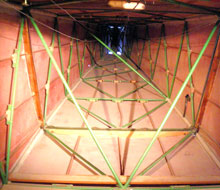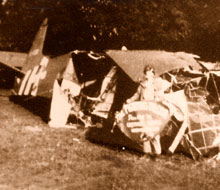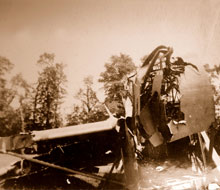Chef-du-Pont
Sainte-Mère-Église

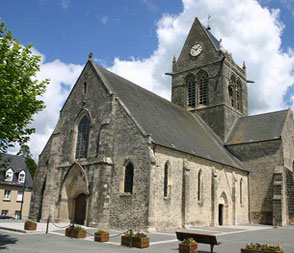
Sainte-Mère-Église and John Steele
One of the most disastrous drops (in a night filled with disasters) occurred in Sainte-Mère-Église. Around midnight, a stray incendiary bomb had set fire to the house of Monsieur Harion, located to the east of the square.
Wakened by the mayor and the tolling of the church bell, the townspeople turned out in large numbers to form a bucket brigade supervised by members of the German garrison. (The hand pump used that night still sits on the east side of the square.) While the house continued to burn, the drone of planes could be heard over the tolling bell. The fire-fighters, looking skyward, saw ghostly silhouettes drifting down on them. Two sticks from the 1st and 2d battalions had gotten their green jump light directly over the village. Illuminated by light from the burning house and tracers from German AA guns, the paratroopers were easy targets for the Germans below. Few survived.
One who did was Private John Steele, whose parachute caught on the steeple of the church in front of you. The wounded paratrooper hung there limply for two hours, pretending to be dead, before the Germans took him prisoner.
The less fortunate hung from the trees all around the square where they had been shot. Once the fire in Monsieur Harion's house had burned itself out and the last of the paratroopers were killed or captured, the German garrison (a transportation company) quite inexplicably called it an evening and turned in.
A mile northeast of Sainte-Mère-Église, Lieutenant Colonel Edward Krause, commanding the 3d Battalion, assembled ninety men within an hour of landing and promptly ordered an advance on the village. Around dawn, the German garrison was again turned out, this time by the rattle of small-arms fire. Krause's men cleared the village in a rush, capturing thirty Germans and killing another eleven. With Sainte-Mère-Église in American hands, Krause ran a worn American flag to the top of the village flagpole, a flag that he had carried with him from Sicily.
The end of the day
D-Day ended with the Americans still in control of Sainte-Mère-Église, and further German attacks during the night failed to dislodge them. For their roles in the capture and defence of Sainte-Mère-Église, both Krause and Col. Vandervoort received the Distinguished Service Cross. All through 6 June, isolated groups of paratroopers were getting their first taste of hedgerow fighting within a few miles of Sainte-Mère-Église.

The City Hall
The Hôtel de Ville (Town Hall) is located just south of the square. In front stands a milestone marking «Kilometer O» on the «liberation route». Behind it is a stone honoring Generals Ridgway and Gavin. Inside the building is the American flag that Lieutenant Colonel Edward Krause raised over the liberated Sainte-Mère-Église. It had earlier flown over liberated Naples.
Link up with the 4th Division
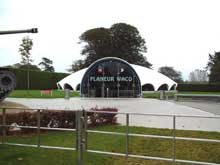
By the afternoon of the 6th, the paratroopers made contact with elements of the 4th Division moving inland from Utah Beach.
They had cut N 13 at Sainte-Mère-Église, thereby preventing the Germans from reinforcing the beach area. By their reduction of strong points at the beach exits, they greatly aided in the movement of the 4th Division off Utah Beach. Much hard fighting lay ahead to clear enemy resistance in the Carentan area, and forge a linkup between the two American beachheads. But it was apparent that Eisenhower's decision to go ahead with the night drop of the two American airborne divisions had been sound.
On one side of the square is the church (built between the eleventh and fifteenth centuries) on which Private John Steele landed. It contains two stained-glass windows commemorating the drop. There is a CD monument in front of the church. Next to it is a memorial to the 1944 mayor, Alexandre Renaud. The hand pump used to fight the fire on the night of 5-6 June still stands at the rear of the square behind the church.
Sainte-Mère-Église Stain glass signification dedicated to 82nd Airborne
This stain glass has been offered by the 505th Regiment to celebrate the 25th Anniversary.

Belgium Lion symbolizing Belgium Campaign
AA: All American emblem as the 48 states
were represented in this Division
Peace Dove
Sainte-Mère dedicated Arms to their Liberators:
82nd and 101st Airborne Divisions
Lorraine Cross symbolizing France Campaign
Glider emblem
Olive tree branch symbolizing Italy Campaign
505 regiment insigna
Saint Michael Protector of the Paratroopers
Tulip symbolizing Holland Campaign
Prior Arms of Ste Mere with a Norman Drakar
City center
Front yard of Charity symbol
Anchor symbol of Hope
Ciboria symbol of faith
Paratrooper insignia
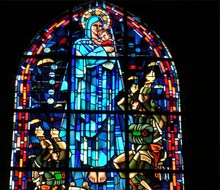
This is the first stain glass produced by Gabriel Loir from Chartres, regrouping around the Virgin Marie, Paratroopers and planes.
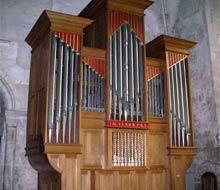
This organ was given by French Companies to commemorate the 50th Anniversary.
American Airborne Museum
Inside of the glider displayed in the American Airborne Museum at Sainte-Mère-Église. I highly recommend the visit of this great Museum.
Airborne Museum
Main Square
Sainte-Mère-Église
Tel: 02 33 41 41 35
